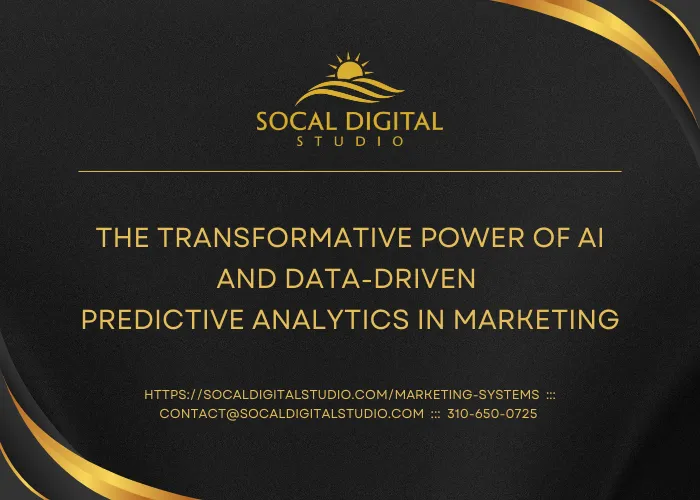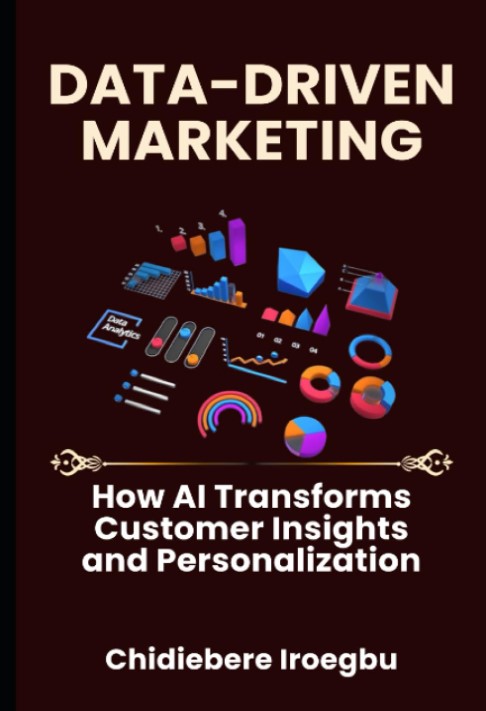PROPELLING SUCCESSFUL BUSINESSES
Actionable Best Practices

The Transformative Power of AI and Data-Driven Predictive Analytics in Marketing
“In a world of more data, the companies with more data-literate people are the ones that are going to win.” - Miro Kazakoff
Introduction
In today's digital era, the landscape of marketing is being revolutionized by the integration of artificial intelligence (AI) and data-driven predictive analytics. These technologies are enabling businesses to leverage massive amounts of data to gain deeper insights, enhance customer engagement, and drive more effective marketing strategies. This article delves into the ways AI and predictive analytics are shaping marketing, providing practical use cases, examples, and steps to implement these technologies effectively.

The Role of AI in Marketing
Artificial intelligence in marketing involves the use of machine learning algorithms, natural language processing (NLP), and other advanced technologies to automate processes, gain insights from data, and improve decision-making. Here are some key areas where AI is making a significant impact:
Customer Segmentation: AI can analyze vast datasets to identify distinct customer segments based on behaviors, preferences, and demographics. This allows marketers to tailor their strategies to specific groups, enhancing relevance and effectiveness.
Personalization: AI-driven personalization engines can deliver customized content and recommendations to individual users in real time. By analyzing user interactions and preferences, businesses can provide a highly personalized experience that increases engagement and conversion rates.
Predictive Analytics: Predictive models use historical data to forecast future trends and behaviors. In marketing, this can mean predicting which customers are most likely to purchase, identifying potential churn risks, or forecasting the success of a campaign.
Chatbots and Virtual Assistants: AI-powered chatbots can handle customer inquiries, provide product recommendations, and even process orders. These virtual assistants improve customer service efficiency and provide a seamless experience.
Content Creation and Curation: AI tools can generate content, such as product descriptions or social media posts, and curate content that resonates with specific audience segments. This reduces the burden on marketing teams and ensures a steady flow of relevant content.
Data-Driven Predictive Analytics in Marketing
Predictive analytics involves using historical data, statistical algorithms, and machine learning techniques to predict future outcomes. In marketing, predictive analytics can be applied in several ways:
Lead Scoring: By analyzing past interactions and behaviors, predictive models can score leads based on their likelihood to convert. This helps sales teams prioritize high-potential leads and allocate resources more effectively.
Customer Lifetime Value (CLV) Prediction: Predictive analytics can estimate the future value a customer will bring to the business. This helps in identifying high-value customers and crafting strategies to retain them.
Churn Prediction: By identifying patterns in customer behavior, predictive models can flag customers at risk of churn. Marketers can then implement targeted retention campaigns to reduce churn rates.
Campaign Optimization: Predictive analytics can forecast the performance of marketing campaigns, enabling marketers to optimize their strategies for maximum impact. This includes determining the best time to launch a campaign, the ideal channels to use, and the most effective messaging.
Use Cases and Steps to Implement AI and Predictive Analytics in Marketing
Let's explore some practical use cases and the steps required to implement AI and predictive analytics in marketing.
1. Customer Segmentation and Personalization
Use Case: An e-commerce company wants to enhance its email marketing strategy by sending personalized product recommendations.
Steps:
Data Collection: Gather data on customer purchases, browsing history, demographics, and interactions.
Data Processing: Clean and preprocess the data to ensure accuracy.
Model Development: Use machine learning algorithms to analyze the data and identify customer segments with similar behaviors and preferences.
Personalization Engine: Implement a personalization engine that uses the model's insights to deliver tailored product recommendations to each segment.
Monitoring and Optimization: Continuously monitor the performance of the recommendations and refine the model to improve accuracy.
2. Lead Scoring
Use Case: A B2B company aims to prioritize its sales efforts by identifying leads with the highest conversion potential.
Steps:
Data Collection: Compile data on past leads, including their characteristics, behaviors, and outcomes.
Feature Engineering: Identify relevant features that influence lead conversion, such as engagement levels, company size, and industry.
Model Training: Train a predictive model using historical data to score leads based on their likelihood to convert.
Integration: Integrate the lead scoring model with the company's CRM system to automatically score new leads.
Validation and Adjustment: Validate the model's predictions against actual outcomes and make necessary adjustments to improve accuracy.
3. Churn Prediction
Use Case: A subscription-based service wants to reduce churn by identifying customers at risk of canceling their subscriptions.
Steps:
Data Collection: Collect data on customer interactions, usage patterns, support tickets, and feedback.
Data Analysis: Analyze the data to identify common patterns and behaviors associated with churn.
Model Development: Develop a predictive model to identify customers at risk of churn.
Intervention Strategies: Create targeted retention campaigns for at-risk customers, such as personalized offers or enhanced support.
Evaluation: Continuously evaluate the effectiveness of retention strategies and refine the model based on feedback.
References
To dive deeper into the topic of AI and predictive analytics in marketing, consider exploring the following resources:
"Artificial Intelligence in Marketing" by Jim Sterne: This book provides an in-depth look at how AI can be leveraged in various marketing activities.
"Predictive Analytics: The Power to Predict Who Will Click, Buy, Lie, or Die" by Eric Siegel: This book offers insights into predictive analytics and its applications across different industries, including marketing.
"Marketing Data Science: Modeling Techniques in Predictive Analytics with R and Python" by Thomas W. Miller: This book covers practical approaches to implementing predictive analytics using popular programming languages.
Online Courses: Platforms like Coursera and edX offer courses on AI and data analytics that can help marketers gain the necessary skills to implement these technologies.
Conclusion
AI and data-driven predictive analytics are transforming the field of marketing by enabling more precise targeting, personalization, and optimization of campaigns. By leveraging these technologies, businesses can gain deeper insights into customer behavior, improve engagement, and drive better outcomes. Implementing AI and predictive analytics requires a systematic approach to data collection, model development, and continuous refinement. With the right strategies and tools, marketers can unlock the full potential of these technologies and stay ahead in a competitive landscape.
We Can Help
Schedule a strategy session with SoCal Digital Studio to explore how you can leverage AI and data-driven marketing into your company's operations. Book time by clicking on this link: Free 1-Hour Consultation (socaldigitalstudio.com) . We are happy to help.
We Help Companies Effectively Evolve and Systematize Their Omnichannel Marketing Strategy
For personalized advice on effectively engaging authentically with your audience on social media and other digital platforms like your website, Google Business Profile and review sites, contact SoCal Digital Studio today. Our experts will help you navigate the world of cost-effective marketing and ensure your company reaches its full potential. Schedule a free impact and strategic session with us by CLICKING HERE to learn how to smartly apply your marketing resources and develop efficient marketing as a competitive advantage in your company. Ask us about SoCalSurge™, the Gold Standard in Comprehensive All-in-One Marketing Systems.
If you need working capital to fund your marketing projects and campaigns to increase your revenue and you generate at least $10K per month, have a chat with John Grantham. He and his company are focused on win-win-win scenarios for small businesses.
Recommended Reading: "Data-Driven Marketing" by Chidiebere Iroegbu.

SUBSCRIBE TO THIS NEWSLETTER TO STAY IN THE KNOW
Please contact us with topics you would like us to cover
Dominate with Our Affordable All-in-One Marketing System
SoCal Digital Studio's Advanced All-In-One Marketing System is built to help local businesses attract, engage, convert, and retain customers with speed and consistency. It automates the communication that is essential to a business' success and continuing growth. Request a free marketing audit to uncover weaknesses and use SoCal Digital Studio's Marketing System to not only compete, but dominate the market.
All-in-One Marketing System
Leverage Powerful Marketing Tools and Sales Funnels to Nurture and Convert Customers at an Affordable Price
Our marketing system has it all and allows you to (1) capture leads via landing pages, forms, calendars, and inbound phone calls; (2) message leads via phone calls, SMS, emails, and Messenger; and (3) close leads with built-in tools for payments and analytics (including call tracking).You can also create landing pages and funnels, set up automated follow-up campaigns, schedule appointments, fine-tune marketing and sales processes, and manage all of it so nothing slips between the cracks in your dedicated marketing system.
Stellar Package
Monthly Subscription
12-Month Subscription is $4970
One-Time Set-Up Fee Varies
$297
Full System Access
5,000 Contacts
1,500 SMS or Calls
15,000 Emails
1-3 Team Members
Galactic Package
Monthly Subscription
12-Month Subscription is $6970
One-Time Set-Up Fee Varies
$497
Full System Access
7,500 Contacts
3,000 SMS or Calls
30,000 Emails
4-10 Team Members
Cosmic Package
Monthly Subscription
12-Month Subscription Is $9970
One-Time Set-Up Fee Varies
$697
Full System Access
10,000 Contacts
4,500 SMS or Calls
45,000 Emails
11-15 Team Members
